Warehouse
A warehouse is a building for storing goods.[1][2] Warehouses are used by manufacturers, importers, exporters, wholesalers, transport businesses, customs, etc. They are usually large plain buildings in industrial parks on the outskirts of cities, towns or villages.
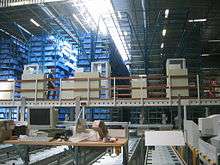
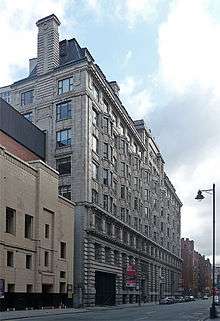
They usually have loading docks to load and unload goods from trucks. Sometimes warehouses are designed for the loading and unloading of goods directly from railways, airports, or seaports. They often have cranes and forklifts for moving goods, which are usually placed on ISO standard pallets loaded into pallet racks. Stored goods can include any raw materials, packing materials, spare parts, components, or finished goods associated with agriculture, manufacturing, and production. In India and Hong Kong, a warehouse may be referred to as a godown.[3] There are also godowns in the Shanghai Bund.
History
Prehistory and ancient history
A warehouse can be defined functionally as a building in which to store bulk produce or goods (wares) for commercial purposes. The built form of warehouse structures throughout time depends on many contexts: materials, technologies, sites, and cultures.
In this sense, the warehouse postdates the need for communal or state-based mass storage of surplus food. Prehistoric civilizations relied on family- or community-owned storage pits, or ‘palace’ storerooms, such as at Knossos, to protect surplus food. The archaeologist Colin Renfrew argued that gathering and storing agricultural surpluses in Bronze Age Minoan ‘palaces’ was a critical ingredient in the formation of proto-state power.[4]
The need for warehouses developed in societies in which trade reached a critical mass requiring storage at some point in the exchange process. This was highly evident in ancient Rome, where the horreum (pl. horrea) became a standard building form.[5] The most studied examples are in Ostia, the port city that served Rome. The Horrea Galbae, a warehouse complex on the road towards Ostia, demonstrates that these buildings could be substantial, even by modern standards. Galba's horrea complex contained 140 rooms on the ground floor alone, covering an area of some 225,000 square feet (21,000 m²). As a point of reference, less than half of U.S. warehouses today are larger than 100,000 square feet (9290 m²).[6]
Medieval Europe
The need for a warehouse implies having quantities of goods too big to be stored in a domestic storeroom. But as attested by legislation concerning the levy of duties, some medieval merchants across Europe commonly kept goods in their large household storerooms, often on the ground floor or cellars.[7][8] An example is the Fondaco dei Tedeschi, the substantial quarters of German traders in Venice, which combined a dwelling, warehouse, market and quarters for travellers.[9]
From the Middle Ages on, dedicated warehouses were constructed around ports and other commercial hubs to facilitate large-scale trade. The warehouses of the trading port Bryggen in Bergen, Norway (now a World Heritage site), demonstrate characteristic European gabled timber forms dating from the late Middle Ages, though what remains today was largely rebuilt in the same traditional style following great fires in 1702 and 1955.
Industrial revolution
.jpg)
During the industrial revolution of the mid 18th century, the function of warehouses evolved and became more specialised. The mass production of goods launched by the industrial revolution of the 18th and 19th centuries fuelled the development of larger and more specialised warehouses, usually located close to transport hubs on canals, at railways and portside. Specialisation of tasks is characteristic of the factory system, which developed in British textile mills and potteries in the mid-late 1700s. Factory processes speeded up work and deskilled labour, bringing new profits to capital investment.
Warehouses also fulfill a range of commercial functions besides simple storage, exemplified by Manchester's cotton warehouses and Australian wool stores: receiving, stockpiling and despatching goods; displaying goods for commercial buyers; packing, checking and labelling orders, and dispatching them.
The utilitarian architecture of warehouses responded fast to emerging technologies. Before and into the nineteenth century, the basic European warehouse was built of load-bearing masonry walls or heavy-framed timber with a suitable external cladding. Inside, heavy timber posts supported timber beams and joists for the upper levels, rarely more than four to five stories high.
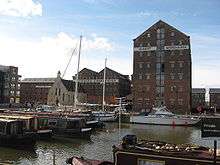
A gabled roof was conventional, with a gate in the gable facing the street, rail lines or port for a crane to hoist goods into the window-gates on each floor below. Convenient access for road transport was built-in via very large doors on the ground floor. If not in a separate building, office and display spaces were located on the ground or first floor.
Technological innovations of the early 19th century changed the shape of warehouses and the work performed inside them: cast iron columns and later, moulded steel posts; saw-tooth roofs; and steam power. All (except steel) were adopted quickly and were in common use by the middle of the 19th century.
Strong, slender cast iron columns began to replace masonry piers or timber posts to carry levels above the ground floor. As modern steel framing developed in the late 19th century, its strength and constructability enabled the first skyscrapers. Steel girders replaced timber beams, increasing the span of internal bays in the warehouse.
The saw-tooth roof brought natural light to the top story of the warehouse. It transformed the shape of the warehouse, from the traditional peaked hip or gable to an essentially flat roof form that was often hidden behind a parapet. Warehouse buildings now became strongly horizontal. Inside the top floor, the vertical glazed pane of each saw-tooth enabled natural lighting over displayed goods, improving buyer inspection.
Hoists and cranes driven by steam power expanded the capacity of manual labour to lift and move heavy goods.
20th century
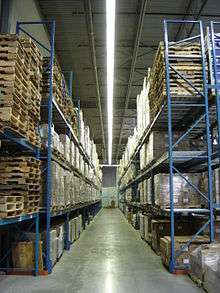
Two new power sources, hydraulics and electricity, re-shaped warehouse design and practice at the end of the 19th century and into the 20th century.
Public hydraulic power networks were constructed in many large industrial cities around the world in the 1870s-80s, exemplified by Manchester. They were highly effective to power cranes and lifts, whose application in warehouses served taller buildings and enabled new labour efficiencies.
Public electricity networks emerged in the 1890s. They were used at first mainly for lighting and soon to electrify lifts, making possible taller, more efficient warehouses. It took several decades for electrical power to be distributed widely throughout cities in the western world.
20th-century technologies made warehousing ever more efficient. Electricity became widely available and transformed lighting, security, lifting and transport from the 1900s. The internal combustion engine, developed in the late 19th century, was installed in mass-produced vehicles from the 1910s. It not only reshaped transport methods but enabled many applications as a compact, portable power plant, wherever small engines were needed.
The forklift truck was invented in the early 20th century and came into wide use after World War II. Forklifts transformed the possibilities of multi-level pallet racking of goods in taller, single-level steel-framed buildings for higher storage density. The forklift, and its load fixed to a uniform pallet, enabled the rise of logistic approaches to storage in the later 20th century.
Always a building of function, in the late 20th century warehouses began to adapt to standardisation, mechanisation, technological innovation and changes in supply chain methods.
Typology
Warehouses are generally considered industrial buildings[10] and are usually located in industrial districts or zones (such as the outskirts of a city).[11] LoopNet categorizes warehouses using the "industrial" property type.[12] Craftsman Book Company's 2018 National Building Cost Manual lists "Warehouses" under the "Industrial Structures Section."[13] In the UK, warehouses are classified under the Town and Country Planning Act 1990 as the industrial category B8 Storage and distribution.[14][15]
Types of warehouses include storage warehouses, distribution centers (including fulfillment centers and truck terminals), retail warehouses, cold storage warehouses, and flex space.[16][17]
Retail warehouses
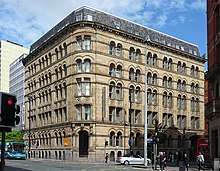
These displayed goods for the home trade. This would be finished goods- such as the latest cotton blouses or fashion items. Their street frontage was impressive, so they took the styles of Italianate Palazzi.
Richard Cobden's construction in Manchester's Mosley Street was the first palazzo warehouse. There were already seven warehouses on Portland Street when S. & J. Watts & Co. commenced building the elaborate Watts Warehouse of 1855,[18][19] but four more were opened before it was finished.
Cool warehouses and cold storage
Cold storage preserves agricultural products. Refrigerated storage helps in eliminating sprouting, rotting and insect damage. Edible products are generally not stored for more than one year. Several perishable products require a storage temperature as low as −25 °C.
Cold storage helps stabilize market prices and evenly distribute goods both on demand and timely basis. The farmers get the opportunity of producing cash crops to get remunerative prices. The consumers get the supply of perishable commodities with lower fluctuation of prices.
Ammonia and Freon compressors are commonly used in cold storage warehouses to maintain the temperature. Ammonia refrigerant is cheaper, easily available, and has a high latent heat of evaporation, but it is also highly toxic and can form an explosive mixture when mixed with fuel oil. Insulation is also important, to reduce the loss of cold and to keep different sections of the warehouse at different temperatures.
There are two main types of refrigeration system used in cold storage warehouses: vapor absorption systems (VAS) and vapor-compression systems (VCS). VAS, although comparatively costlier to install, is more economical in operation.
The temperature necessary for preservation depends on the storage time required and the type of product. In general, there are three groups of products, foods that are alive (e.g. fruits and vegetables), foods that are no longer alive and have been processed in some form (e.g. meat and fish products), and commodities that benefit from storage at controlled temperature (e.g. beer, tobacco).
Location is important for the success of a cold storage facility. It should be in close proximity to a growing area as well as a market, be easily accessible for heavy vehicles, and have an uninterrupted power supply.
Overseas warehouses
These catered for the overseas trade. They became the meeting places for overseas wholesale buyers where printed and plain could be discussed and ordered.[18] Trade in cloth in Manchester was conducted by many nationalities.
Behrens Warehouse is on the corner of Oxford Street and Portland Street. It was built for Louis Behrens & Son by P Nunn in 1860. It is a four-storey predominantly red brick build with 23 bays along Portland Street and 9 along Oxford Street.[19] The Behrens family were prominent in banking and in the social life of the German Community in Manchester.[20] [21]
Packing warehouses
Modern term: Fulfillment house
The main purpose of packing warehouses was the picking, checking, labelling and packing of goods for export.[18] The packing warehouses: Asia House, India House and Velvet House along Whitworth Street in Manchester were some of the tallest buildings of their time. See List of packing houses.
Railway warehouses
Warehouses were built close to the major stations in railway hubs. The first railway warehouse to be built was opposite the passenger platform at the terminus of the Liverpool and Manchester Railway. There was an important group of warehouses around London Road station (now Piccadilly station).In the 1890s the Great Northern Railway Company’s warehouse was completed on Deansgate: this was the last major railway warehouse to be built.[18]
The London Warehouse Picadilly was one of four warehouses built by the Manchester, Sheffield and Lincolnshire Railway in about 1865 to service the new London Road Station. It had its own branch to the Ashton Canal. This warehouse was built of brick with stone detailing. It had cast iron columns with wrought iron beams.[22]
Canal warehouses
All these warehouse types can trace their origins back to the canal warehouses which were used for trans-shipment and storage. Castlefield warehouses are of this type- and important as they were built at the terminus of the Bridgewater Canal in 1761.
Operations
A customised storage building, a warehouse enables a business to stockpile goods, e.g., to build up a full load prior to transport, or hold unloaded goods before further distribution, or store goods like wine and cheese that require maturation. As a place for storage, the warehouse has to be secure, convenient, and as spacious as possible, according to the owner's resources, the site and contemporary building technology. Before mechanised technology developed, warehouse functions relied on human labour, using mechanical lifting aids like pulley systems.
Storage and shipping systems
Some of the most common warehouse storage systems are:
- Pallet racking including selective, drive-in, drive-thru, double-deep, pushback, and gravity flow
- Cantilever racking uses arms, rather than pallets, to store long thin objects like timber.
- Mezzanine adds a semi-permanent story of storage within a warehouse[23]
- Vertical Lift Modules are packed systems with vertically arranged trays stored on both sides of the unit.
- Horizontal Carousels consist of a frame and a rotating carriage of bins.
- Vertical Carousels consisting of a series of carriers mounted on a vertical closed-loop track, inside a metal enclosure.
A "piece pick" is a type of order selection process where a product is picked and handled in individual units and placed in an outer carton, tote or another container before shipping. Catalog companies and internet retailers are examples of predominantly piece-pick operations. Their customers rarely order in pallet or case quantities; instead, they typically order just one or two pieces of one or two items. Several elements make up the piece-pick system. They include the order, the picker, the pick module, the pick area, handling equipment, the container, the pick method used and the information technology used.[24] Every movement inside a warehouse must be accompanied by a work order. Warehouse operation can fail when workers move goods without work orders, or when a storage position is left unregistered in the system.
Material direction and tracking in a warehouse can be coordinated by a Warehouse Management System (WMS), a database driven computer program. Logistics personnel use the WMS to improve warehouse efficiency by directing pathways and to maintain accurate inventory by recording warehouse transactions.
Automation and optimization
Some warehouses are completely automated, and require only operators to work and handle all the task. Pallets and product move on a system of automated conveyors, cranes and automated storage and retrieval systems coordinated by programmable logic controllers and computers running logistics automation software. These systems are often installed in refrigerated warehouses where temperatures are kept very cold to keep the product from spoiling. This is especially true in electronics warehouses that require specific temperatures to avoid damaging parts. Automation is also common where land is expensive, as automated storage systems can use vertical space efficiently. These high-bay storage areas are often more than 10 meters (33 feet) high, with some over 20 meters (65 feet) high. Automated storage systems can be built up to 40m high.
For a warehouse to function efficiently, the facility must be properly slotted. Slotting addresses which storage medium a product is picked from (pallet rack or carton flow), and how they are picked (pick-to-light, pick-to-voice, or pick-to-paper). With a proper slotting plan, a warehouse can improve its inventory rotation requirements—such as first in, first out (FIFO) and last in, first out (LIFO)—control labor costs and increase productivity.[25]
Pallet racks are commonly used to organize a warehouse. It is important to know the dimensions of racking and the number of bays needed as well as the dimensions of the product to be stored.[26] Clearance should be accounted for if using a forklift or pallet mover to move inventory.
Recent trends
Modern warehouses commonly use a system of wide aisle pallet racking to store goods which can be loaded and unloaded using forklift trucks.
Traditional warehousing has declined since the last decades of the 20th century, with the gradual introduction of Just In Time techniques. The JIT system promotes product delivery directly from suppliers to consumer without the use of warehouses. However, with the gradual implementation of offshore outsourcing and offshoring in about the same time period, the distance between the manufacturer and the retailer (or the parts manufacturer and the industrial plant) grew considerably in many domains, necessitating at least one warehouse per country or per region in any typical supply chain for a given range of products.
Recent retailing trends have led to the development of warehouse-style retail stores. These high-ceiling buildings display retail goods on tall, heavy-duty industrial racks rather than conventional retail shelving. Typically, items ready for sale are on the bottom of the racks, and crated or palletized inventory is in the upper rack. Essentially, the same building serves as both a warehouse and retail store.
Another trend relates to vendor-managed inventory (VMI). This gives the vendor the control to maintain the level of stock in the store. This method has its own issue that the vendor gains access to the warehouse.
Large exporters and manufacturers use warehouses as distribution points for developing retail outlets in a particular region or country. This concept reduces end cost to the consumer and enhances the production sale ratio.
Cross-docking is a specialised type of distribution center (DC) in that little or no inventory is stored and product is received, processed (if needed) and shipped within a short timeframe. As in warehousing, there are different types of cross-docks.
Reverse logistics is another type of warehousing that has become popular for environmental reasons. The term refers to items that are going from the end user back to the distributor or manufacturer.
Education
There are few non-profit organizations which are focused on imparting knowledge, education and research in the field of warehouse management and its role in the supply chain industry. The Warehousing Education and Research Council (WERC)[27] and International Warehouse Logistics Association (IWLA)[28] in Illinois, United States. They provide professional certification and continuing education programs for the industry in the country. The Australian College of Training have government funded programs to provide personal development and continuation training in warehousing certs II – V (Diploma), they operate in Western Australia online and face to face, or Australia wide for online only courses.
Safety
Warehousing has unique health and safety challenges and has been recognized by the National Institute for Occupational Safety and Health (NIOSH) as a priority industry sector in the National Occupational Research Agenda (NORA) to identify and provide intervention strategies regarding occupational health and safety issues.[29][30]
See also
- Automated storage and retrieval system
- Document automation
- Data warehouse
- Inventory
- Inventory management software
- Pick and pack
- RFID
- Shipping list
- Voice Directed Warehousing
- Warehouse management system
References
- Harris, Cyril M. (2006). "Warehouse". Dictionary of Architecture & Construction (4th ed.). McGraw-Hill. p. 1056. ISBN 978-0071452373.
warehouse: A building designed for the storage of various goods.
- Davies, Nikolas; Jokiniemi, Erkki (2008). "warehouse". Dictionary of Architecture and Building Construction. Elsevier. p. 410. ISBN 978-0-7506-8502-3.
warehouse: a large building for storing goods and products prior to distribution; a storehouse.
- "godown - Definition of godown in English by Oxford Dictionaries". Oxford Dictionaries - English.
- Renfrew, Colin (1972). The Emergence of Civilisation: The Cyclades and the Aegean in the Third Millennium BC. London: Methuen. ISBN 0-416-16480-3.
- Rickman, Geoffrey (1971). Roman Granaries and Store Buildings. Cambridge: Cambridge University Press. ISBN 0-521-07724-9.
- Anon., Michael (15 October 2018). "A History of the Warehouse". Action Storage. Archived from the original on
|archive-url=requires|archive-date=(help). - Schulz, Jurgen (2004). The New Palaces of Medieval Venice. University Park PA: Penn State Press. p. 26. ISBN 0-271-04836-0.
- Carus-Wilson, E.M. (2013). Medieval Merchant Venturers: Collected Studies. Hoboken NJ: Routledge. ISBN 978-1-136-58279-0.
- Friedman, John Block (1) & Figg, Kristeb Mossler (2), Eds (2000). Trade, Travel, and Exploration in the Middle Ages: An Encyclopedia. New York: Garland. p. 196. ISBN 978-1-135-59094-9.CS1 maint: multiple names: authors list (link)
- Sicola, Maria (March 2017). "Industrial Terminology" (PDF). Commercial Real Estate Terms and Definitions. The NAIOP Research Foundation. pp. 21–26.
- "Types of Zoning". Findlaw. Thompson Reuters. Retrieved 2018-12-17.
Office buildings, shopping centers, nightclubs, hotels, certain warehouses, some apartment complexes -- as well as vacant land that has the potential for development into these types of buildings -- can all be zoned as commercial. Almost any kind of real estate (other than single-family home and single-family lots) can be considered commercial real estate... Manufacturing plants and many storage facilities have industrial zoning.
- Jackson, John B. (2016-04-08). Warehouse Veteran: Your Tactical Field Guide to Industrial Real Estate. INDCRE Publishing. ISBN 9780997329803.
- Pratt, Andy C.; Ball, Rick (2018-01-12). "Industrial property, policy and economic development: The research agenda". In Ball, Rick; Pratt, Andy C. (eds.). Industrial Property: Policy and Economic Development. Routledge. ISBN 9781351330619.
The Valuation Office produces a very useful Property Market Report (PMR)...There is a section of the report that deals specifically with industrial property...The capital values are broken down into four categories: small starter units...nursery units...industrial/warehouse units (circa 500 square meters); and industrial/warehouse units (circa 1,000 square metres).
- Jowsey, Ernie (2014-07-11). Real Estate Concepts: A Handbook. Routledge. § 3.5. ISBN 9781135084424.
Although industrial property is such a large commercial property sector and its buildings can range in size from a small business workshop...up to a large warehouse...the sector generally includes the following types of properties: logistic centres; warehouses; distribution centers; industrial estates.
- Jowsey, Ernie (2014-07-11). Real Estate Concepts: A Handbook. Routledge. § 3.5. ISBN 9781135084424.
From a property perspective, industrial property is property (land and buildings) that can be used for a variety of purposes, with the following being the most common uses: ... storage;...The main types of property invested in in the UK are: 1 Shops (retail sector...2 Offices...3 Industrial factories and warehouses...
- Gilmour, Emma (2016-06-28). "Industrial property: what is it?". www.realcommercial.com.au. Retrieved 2018-12-17.
- Commercial Real Estate (2018-02-26). "Shortage of industrial real estate is pushing companies out of Vancouver | Financial Post". Retrieved 2018-12-17.
- Schmidt, Robert (2013-02-27). "Types of Commercial Real Estate". PropertyMetrics. Retrieved 2018-12-17.
- "Types of Zoning". Findlaw. Thompson Reuters. Retrieved 2018-12-17.
- Jowsey, Ernie (2014-07-11). Real Estate Concepts: A Handbook. Routledge. § 3.5. ISBN 9781135084424.
Warehouses are used for storage of goods by manufacturers, importers, exporters, wholesalers, transport businesses, customs, etc. They are usually large open space buildings in industrial areas of cities and towns.
- "Warehouses for Sale". LoopNet. Retrieved 2018-12-17.
- Moselle, Ben, ed. (2018). "2018 National Building Cost Manual" (PDF). Craftsman (42nd ed.). p. 3. Retrieved 2018-12-17.
- Jowsey, Ernie (2014-07-11). Real Estate Concepts: A Handbook. Routledge. § 3.5. ISBN 9781135084424.
From a UK planning perspective, industrial property use generally classified under the Use Classes Order 2010 as: ... B8 Storage or Distribution...
- Jowsey, Ernie (2014-07-11). Real Estate Concepts: A Handbook. Routledge. § 7.5. ISBN 9781135084424.
Factories and warehouses usually have shorter building life than offices and most shops, and so the impact of depreciation on them is greater. As a result, yields on industrial property are normally significantly higher than those on other commercial property.
- Sicola, Maria (March 2017). "Retail Terminology" (PDF). Commercial Real Estate Terms and Definitions. The NAIOP Research Foundation. pp. 32–36.
- Schmidt, Robert (2018-11-25). "Types of Commercial Real Estate". PropertyMetrics. Retrieved 2018-11-25.
- Wyke, Terry. "Manchester warehouses". Revealing Histories: Remembering Slavery. Manchester City Galleries. Retrieved 24 January 2012.
- Parkinson-Bailey 2000, p. 81
- Parkinson-Bailey 2000, p. 84
- Coates, Su (1991–92). "German Gentlemen: Immigrant Institutions in a Provincial City 1840–1920" (PDF). Manchester Region History Review. 5 (2). Archived from the original (PDF) on 2012-02-10. Retrieved 2012-09-09.
- Moss, John (2011-11-15). "Victorian Manchester: Textile Industries & Warehouses". Manchester 2000 Virtual Encyclopedia. Manchester: Papillon Graphics. Archived from the original on 27 January 2012. Retrieved 26 January 2012.
- "Pallet Racking Systems Ltd". 2014-02-18. Retrieved 26 February 2016.
- OPSdesign Consulting (September 1, 2009). PICK THIS! A Compendium of Piece-Picking Process Alternatives. Warehousing Education & Research Council (WERC). ISBN 9781892663467.
- Effectively Slotting a Warehouse or Distribution Center by Paul Hansen and Kelvin Gibson. Cygnus Supply and Demand Chain Executive. Accessed 2010-08-06.
- "Installation Guide to Warehouse Storage Rack Systems - Rack Express". www.rackexpress.com.
- "Warehouse Education & Research Council - Warehouse Certification and Online Programs". www.edumaritime.net.
- "International Warehouse Logistics Association (IWLA) - Certified Logistics Professional Program". www.edumaritime.net.
- "CDC - NIOSH Program Portfolio : Transportation, Warehousing and Utilities". www.cdc.gov. 2019-03-14. Retrieved 2019-03-14.
- "CDC - NORA - Transportation, Warehousing and Utilities Sector Council". www.cdc.gov. 2019-02-12. Retrieved 2019-03-14.
Further reading
- Kumar (2014). warehouse – Layout Planning and Part Feeding Methods. Yes Dee Publishing Pvt Ltd. ISBN 9789380381381.
- The Story of the Bale.. Manchester: Lloyd's Packing Warehouses Ltd, Princess Street, 1926
- Taylor, Simon, et al. (2002) Manchester - the warehouse legacy: introduction and guide; text by Simon Taylor, Malcolm Cooper and P. S. Barnwell. English Heritage ISBN 9781873592670
External links
| Wikimedia Commons has media related to Warehouses. |
| Look up warehouse in Wiktionary, the free dictionary. |